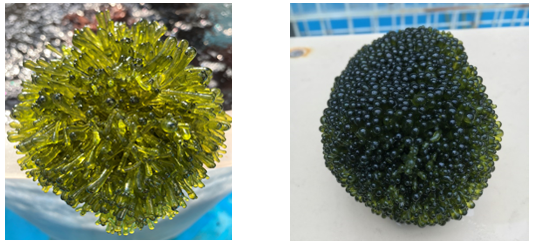News
A shining emerald in the ocean - Valonia aegagropila
- PostDate:2022-01-19
Seaweed is not only an important basic producer of the ocean but is also closely related to human life. In addition to being edible, seaweed can be used as a raw material for healthy food, beauty, and medical supplies, as well as an ornament and being therapeutic. According to the Fisheries Research Institute, it has recently started to develop a cultivation and application technology for Valonia aegagropila, which is common seaweed found in the eastern sea area of Taitung, when the algae were discovered to have the characteristics of high potassium content. In the future, the analysis and research of its functional components will be strengthened to improve its utilization and added value to promote the development of the seaweed industry in Taiwan.
As pointed out by the Fisheries Research Institute, Valonia aegagropila belongs to Valonia of Valoniaceae, Siphonocladales, Ulvophycean, Chlorophyta. The algae are dark green and consist of many cylindrical multinucleated cells that are tightly connected. There is a large vacuole in the mature cell, and the base is attached to other objects by rhizoids. While it is mainly distributed in tropical and subtropical waters, it is more common in the southern and eastern seas of Taiwan. It generally grows on reefs near the low tide line to a depth of 2 meters in the subtidal zone and is often found in June and July.
According to the Fisheries Research Institute, Valonia aegagropila has long been used as a model algae species for ion exchange and osmotic pressure regulation studies of biofilms, but it is still rarely used commercially. While it is only sold in Japan as a healing product under the name of "Deep Sea Green Elf-Bubble", it has now been introduced to Taiwan. With strong potential, the algae can be cultured in a fixed, floating, or rolling manner, and will have different appearances and colors depending on the cultivation method and location. For example, when the ambient water temperature is low, the algae become smaller and denser, and when the water temperature is high, the algae will be larger and sparser. When the light is strong, the algae will be emerald green, otherwise, it will be dark green; the algae will aggregate into a spherical shape in the rolling culture, and will have a thorn-like shape in the fixed culture. The outer layer of the algae is tough and not easy to break. The growth rate is slow, and it is easy to cultivate as the requirement for nutrients is not high. As its color is crystal clear, and it can be connected to a round or attractive spherical appearance, it is very suitable as ornamental algae.
The Fisheries Research Institute stated that its research on the preservation, culture, and antioxidative ability of Valonia aegagropila has been completed. Furthermore, it was found that the algae have the characteristics of high potassium (10,400 mg/kg), which is higher than that of bananas (3,250 mg/kg). Although Valonia aegagropila has not been listed as an edible algae species, its crude extract has excellent antioxidant capacity. Due to its healthy and safe natural material, it may be used in the production of related products in the future. It is hoped that in the near future, Valonia aegagropila can become a shining emerald in the ocean.

Figure 1. The appearances of Valonia aegagropila cultivated in different ways are also different. The picture on the left is cultivated in the flowing water floating culture in an outdoor FRP tank, while the picture on the right is cultivated in the wine fruit barrel rolling culture in an indoor plant growth box.

Figure 2. Clustered Valonia aegagropila in the shape of a heart


